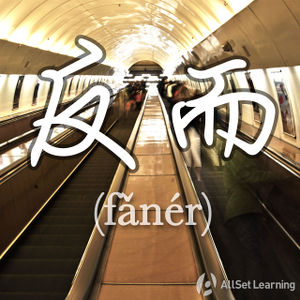Comparing "fan'er" and “xiangfan"
\r\nThe differences 反而 (fǎn'ér) and 相反 (xiāngfǎn) are pretty clear. 反而 is an adverb, while 相反 is an adjective, and this determines how they are used grammatically. \r\n== They are put in different parts of the sentence ==\r\n相反 can be put in the middle of a sentence,and when you use it it should be separated with a comma. 反而 can only be a part of a whole sentence, and cannot include punctuation, however it can be placed in the middle of a sentence. \r\n === Structure ===\r\n
A,相反,B
\r\n
A,反而B
\r\n=== Examples ===\r\n
- 这 个 方法 对 他 来说 没用,相反,对 我 有用。According to him, this method isn't useful, but for me, I think it is.
- 吃 水果 不但 对 他 没 好处,反而 有 坏处。Not only does eating fruit not benefit him, it actually is bad for him.
\r\n== They are used in different situations ==\r\n反而 is used in the context of the speaker expecting some kind of turning point. 相反 is for similar things that have a different aspect. “反而” conveys that the difference between what was expected and what actually happened was quite large. "相反" isn't as strong. \r\n=== Structure ===\r\n
expectation,相反,non-expectation
\r\n
expectation,反而 + opposite of expectation
\r\n=== Examples ===\r\n
- 好 好 工作 就 会 升职,相反,不 好 好 工作 是 不 会 升职 的。In a good job, you can move up the ranks, but in a bad job, you can't.
- 老板 没有 生气,反而 让 我 提 了 更 多 的 建议。The boss didn't get angry. Instead, he gave me a lot of suggestions.
\r\n== 相反 can act as an attribute ==\r\n相反 is an adjective, and of course it can also be an attribute. Just make sure to add a 的 after it. 反而 cannot be used this way.\r\n === Structure ===\r\n
相反 + 的 + Noun.
\r\n=== Examples ===\r\n
- 这 是 两 个 完全 相反 的 结果。These are two completely opposite results.
- 你 应该 朝 相反的 方向 走。You should go down a different path.
\r\n== 相反 can be the predicate ==\r\n相反, like all other adjectives, can be placed after the subject as the predicate of the sentence. Sometimes you can also say 正好相反.\r\n === Structure ===\r\n
Subject + 相反
\r\n=== Examples ===
- 这 两 种 艺术 的 表现 形式 相反。These two art pieces have completely different forms.
- 我们 的 看法 是 相反 的。Our perspectives are not the same.
\r\n== 相反 can also be a short phrase ==\r\n=== Structure ===\r\n
A 跟/和 B 相反
\r\n=== Examples ===
- 老板 的 想法 跟 我 的 相反。The boss's way of thinking and mine don't match up.
- 现在 的 观念 和 以前 的 相反。The views of today are different from what they were in the past.
\r\n== See also ==\r\n== Sources and further reading ==\r\n=== Books ===
- 对外汉语教学语法释疑201例 (相反 vs 反而 p.184) →buy\r\n*现代汉语八百词(增订本) (反而p.199 相反p.574) →buy\r\n*现代汉语虚词例释 (反而p.172 相反p.504)→buy\r\n*卓越汉语-公司实战篇 (pp. 19-20) →buy\r\n=== Dictionaries ===
- 现代汉语词典(第5版) (相反p.1484 反而p.377) →buy\r\n



